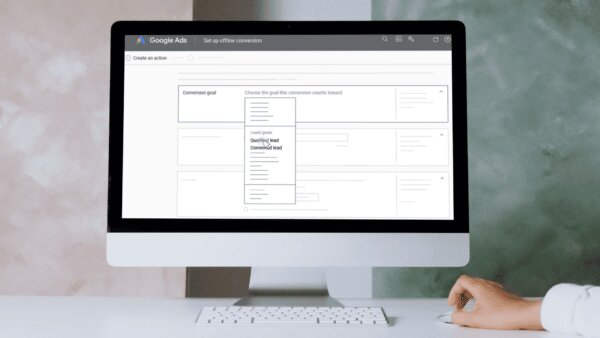5 best practices for tracking offline conversions in Google Ads

Setting up offline conversions for the first time? Here’s how to get started while avoiding volatility in your PPC campaigns.
I like to think of myself as a calculated risk-taker. Because I have TSA PreCheck and monitor my flight status from home, I arrive at the airport just an hour before my flight. I try new restaurants in town, but don’t get in the car until I’ve scoured review sites and scanned the menu.
My approach to taking risks at work is similar. Testing the latest bidding strategies excites me, but my moves are deliberate to avoid disturbing performance.
Major changes to a Google Ads account send the algorithms into a learning phase and create volatility as it re-learns.
Like many marketers who want results yesterday, my patience can be short. But to keep clients happy, balancing future-forward strategies with the risk of upsetting KPIs is imperative.
By now, we know that offline conversion tracking (OCT) is a must-have in any account.
When setting it up for the first time, swapping out web-based campaign optimization goals for CRM-based goals can be tricky. Here are five best practices to mitigate the risk.
1. Add values to your conversions
Maximizing the potential of OCT requires assigning each action a value.
If you can’t use actual and dynamic values from your CRM, Google has a calculator that can help with estimations.
The values don’t have to be precise for the algorithms to benefit from this provided direction.
The assigned values tell machine learning how much each conversion is worth. Therefore, the system can bid accordingly with value-based bidding strategies.
Even if you’re not ready for target return on ad spend (tROAS) or Maximize conversion value, setting these values from the get-go allows for an easy launch when you’re ready.
2. Optimize for all funnel stages
Once all stages of your marketing funnel feed into Google Ads with their respective values, begin optimizing campaigns for all funnel stages.
This tactic will generate more conversion data for your campaigns and speed up the learning phase.
A risk-taker might change the optimization across the account all at once. Go ahead and rip the bandage off:
- If you can stomach performance fluctuations.
- If the account is brand new.
- Or if conversion volume is already dismal.
I prefer to set up an experiment for any major bidding changes to cut down the volatility in the account.
Experiments should run for at least two weeks before determining a winner, but this can take longer if your budgets are small or the conversion lag is long.
A lift in backend conversions should be measured as the key success metric of this experiment.
3. Optimize for the lowest conversion point possible
Once the full-funnel approach is successful, you can begin optimizing for one conversion event at a time. Treat each campaign uniquely and adjust the campaigns ready to move down the funnel.
To ease performance fluctuations, set up an experiment that optimizes to the lowest point in the funnel possible, given Google’s need to have at least 15 conversions in the past 30 days.
Creating custom columns in the Google Ads interface allows you to sort and visualize your data easily. Analyze each campaign independently.
In this example, the top two campaigns have enough MQL volume to optimize for MQLs exclusively rather than the entire funnel.

Consider that not all keywords are created equal. Top-of-funnel keywords will generate pipeline slower than your high-intent non-brand or brand terms.
Individual campaigns’ optimization goals and bidding strategies should align with the funnel stage, and what’s working best.
The UI doesn’t allow OCT goals to be set as single conversion events but rather as the conversion category as a whole. Therefore, custom goals should be created when optimizing toward a single point in the funnel.
For example, if your OCT conversion is “sales,” you should create a custom goal for “sales.”
Google says “[…] using custom goals in campaigns might make your bid strategy work less efficiently,” but if your account is well-established with sufficient data, custom goals should work to your benefit.

4. Continue to drive lower-funnel results
As time goes on and data collects, you can continue to push the limits and optimize for lower points in the funnel.
Any bidding strategy can be tested alongside this tactic, but it’s critical that the experiment you create only changes one variable at a time.
For example, the control campaign is on target cost-per-action (tCPA) and optimized for MQLs. The test campaign should remain on tCPA but optimize for the next stage in the funnel (Meeting Scheduled). After a winner is determined, test another variable by conducting a separate experiment.
Depending on the size of the account, nailing down the perfect combination of optimization goals and bidding strategies can take several months. Seeing little to no performance improvement after the initial two weeks can be worrisome, but running experiments for three full cycles is recommended to determine a winner.
This means if it takes an average of two weeks for an MQL to become a “Meeting Scheduled,” you should run the experiment for at least six weeks before calling it quits. Check out Google’s path metrics report to view how many days each conversion takes.

5. Test value-based bidding
Once you are comfortable optimizing for lower-funnel conversion points, step up your game with Maximize conversion value or tROAS bidding strategies.
These smart bidding strategies adjust bids automatically to predict the value of a potential conversion when a user searches for keywords you’re bidding on.
These bidding strategies can and should be tested in an experiment, especially if you’re terrified of breaking the algorithm.
Despite the risks associated with performance fluctuations, the benefits should outweigh the volatility.
With some patience and breathing exercises, one of my clients saw a 74% improvement in cost per MQL since optimizing for backend conversions with OCT.
When their brand campaign had more than 15 MQLs in a month, we switched to optimizing for MQLs only, resulting in a 4x boost in conversion value on that campaign.
So, get out there and take calculated risks. Be smart, bold and eager to set up experiments when you’re feeling apprehensive.


